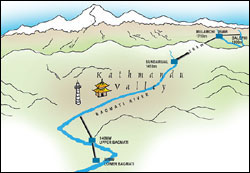It has been 30 years since Melamchi was identified as a potential source of additional water for Kathmandu Valley. The project has since been scaled back, delayed and is now stuck.
By the time it is completed, if ever, Kathmandu will probably need more water than it is designed for. Some experts are therefore proposing an even more ambitious Melamchi project that will add hydropower and irrigation component.
As it stands today, Melamchi will bring pure Himalayan glacial melt through a 26km tunnel to Sundarijal on the outskirts of Kathmandu. The lead agency pushing this $500 million project is the Manila-based Asian Development Bank (ADB) and its board meets to discuss Melamchi in late January.
Experts say the present Melamchi will not meet future water demands of the Valley. The project should add an irrigation component so that the tarai can also benefit, and hydropower generation to not just meet Nepal's energy needs but also offset the cost by bringing in private investment.
"There is so much investment in Melamchi, it is imperative that the project be made sustainable and viable so that areas other than Kathmandu can also benefit," says Padam Sunder Joshi of the NGO Forum for Urban Water and Sanitation.
The new proposal calls for collecting water also from the Balephi River in Sindhupalchok, a larger diameter tunnel to Sundarijal so that the water can also used to generate electricity in a cascade.
The tunnel is currently designed to bring water from Melamchi, Yangri and Larke rivers. Demand estimates show that water from these rivers will meet the needs of Kathmandu only till 2022.
"By the time the project is ready, there will be water scarcity once again," argues economist Ratna Sansar Shrestha, "if Balephi is added, the project can meet Kathmandu's demand beyond 2050."
One of the main arguments against Melamchi in its present form is that it only benefits the capital. The expanded Melamchi, however, can generate up to 225 megawatts of power and provide irrigation to more than 30,000 hectares downstream. "Melamchi would therefore no longer just be a water supply project, but a water resource management scheme with benefits beyond Kathmandu to the tarai," says Bhushan Tuladhar of the Environment and Public Health Organisation (ENPHO).
Hydropower was included in the early designs of Melamchi but was later abandoned. Studies show a 35 megawatt plant could be sited just before the water enters the tunnel in Melamchi and another 190 megawatts generated below Chobar.
Adding a hydropower component could also turn this into a private-public partnership. Private companies would develop the upstream hydropower, with the penstock pipes and tunnels doubling as water supply conveyance to deliver clean desilted water to the city. The same company can then be involved in using the water as it leaves Kathmandu Valley and drops to the tarai to generate electricity again on the Bagmati River.
"A multi-purpose Melamchi would be the perfect model for water supply, irrigation and power generation," says Tuladhar of ENPHO.
All this would be possible by increasing the diameter of the proposed tunnel from 3.7m to 5m. "The cost of construction per metre of tunnel does not go up significantly up to a maximum diameterof 5.6m ," explains Shrestha. A larger tunnel can be constructed faster as heavy duty wheeled transport can be used to remove the rock.
Although this proposal hasn't been publicly debated, those who have sounded out the politicians say that there has been a positive response. "The prime minister, finance minister, the Maoists, other opposition parties and members of National Planning Commission, the ADB are all convinced," says Shrestha.
The only aspect worrying the experts lobbying for an expanded multi-purpose Melamchi is criticism that Kathmandu's water supply augmentation is going to be further delayed. "It's a good plan, but it was drawn up at the eleventh hour," admits Rama Kant Gauro at the National Planning Commission.
But Joshi thinks the delays may not be that significant. "After all, construction hasn't begun yet, the changes we propose are only in the design phase which may take a few extra months," he says. "Besides, the hydropower part can come later and will not interfere with the water supply component."



